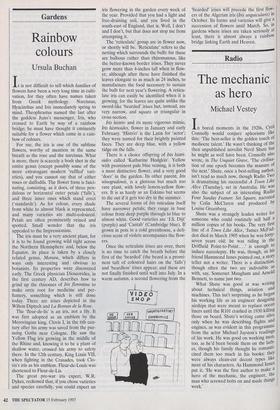Gardens
Rainbow colours
Ursula Buchan
It is not difficult to tell which families of flowers have been a very long time in culti- vation, for they often have names taken from Greek mythology. Narcissus, Hyacinthus and Iris immediately spring to mind. Theophrastus named the last after the goddess Juno's messenger, Iris, who crossed to Earth by way of a rainbow bridge; he must have thought it eminently suitable for a flower which came in a rain- bow of colours.
For me, the iris is one of the sublime flowers, worthy of mention in the same breath as the rose and the narcissus. What is more, there is scarcely a bosh shot in the entire genus (except possibly some of the more extravagant modern 'ruffled' vari- eties), and you cannot say that of either roses or daffodils. The flower form is fasci- nating, consisting, as it does, of three pen- dulous or horizontal outer petals (`falls'), and three inner ones which stand erect (`standards'). As for colour, every shade from white to almost black is represented, and many varieties are multi-coloured. Petals are often prominently veined and spotted. Small wonder that the iris appealed to the Impressionists.
The iris must be a very ancient plant, for it is to be found growing wild right across the Northern Hemisphere and, below the Equator, its place is taken by a closely related genus, Moraea, which differs in ways only interesting and obvious to botanists. Its properties were discovered early. The Greek physician Dioscorides, in the first century AD, describes how to grind up the rhizomes of Iris florentina to make orris root for medicine and per- fumery, something which is still done today. There are irises depicted in the Wilton Diptych and La Roman de la Rose.
The 'fleur-de-lis' is an iris, not a lily. It was first adopted as an emblem by the Merovingian king, Clovis I, in the 6th cen- tury after his army was saved from the pur- suing Goths near Cologne. He saw the Yellow Flag iris growing in the middle of the Rhine and, knowing it to be a plant of shallow water, crossed his army to safety there. In the 12th century, King Louis VII, when fighting in the Crusades, took Clo- vis's iris as his emblem. Fleur-de-Louis was shortened to Fleur-de-Lis.
The great pre-war iris expert, W.R. Dykes, reckoned that, if you chose varieties and species carefully, you could expect an iris flowering in the garden every week of the year. Provided that you had a light and free-draining soil, and you lived in the south-east of England, that is. Well, I don't and I don't, but that does not stop me from attempting it.
The 'reticulate' group are in flower now, or shortly will be. 'Reticulate' refers to the netting which surrounds the bulb; for these are bulbous rather than rhizomatous, like the better-known border irises. They never grow more than 4-inches tall when in flow- er, although after these have finished the leaves elongate to as much as 24 inches, to manufacture the food necessary to sustain the bulb for next year's flowering. A reticu- late iris can easily be identified when it is growing, for the leaves are quite unlike the sword-like 'bearded' irises but, instead, are very narrow, and square or triangular in cross section.
Iris histrio and its more vigorous mimic, Iris histrioides, flower in January and early February. 'Histrio' is the Latin for 'actor% they were named for their brightly painted faces. They are deep blue, with a yellow ridge on the falls.
There is a choice offspring of Iris histri- aides called 'Katharine Hodgkin'. Yellow with prominent pale blue veining, it is both a most distinctive flower, and a very good `doer' in the garden. Its other parent, Iris winogradowii, is a glorious but much too rare plant, with lovely lemon-yellow flow- ers. It is as hardy as an Eskimo but seems to die out if it gets too dry in the summer.
The several forms of Iris reticulata itself have narrower petals; they range in base colour from deep purple through to blue to almost white. Good varieties are 'IS. Dijt' (purple) and 'Cantab' (Cambridge blue). If grown in pots in a cold greenhouse, a deli- cious scent of violets accompanies the flow- ers.
Once the reticulate irises are over, there is no time to catch the breath before the first of the 'bearded' (the beard is a promi- nent tuft of coloured hairs on the 'falls') and 'beardless' irises appear; and these are not finally finished until well into July. In a warm autumn, a second flowering from the `bearded' irises will precede the first flow- ers of the Algerian iris (Iris unguicularis) in October. Its forms and varieties will give a i succession of flowers until March. So, in gardens where irises are taken seriously at least, there is almost always a rainbow bridge linking Earth and Heaven.


























































 Previous page
Previous page